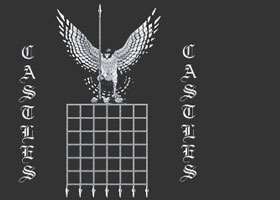Medieval Castle ArchitectureThe History of Medieval Castle Architecture
The History of Medieval Castle Architecture dates back to the Normans. This was an exciting time in Medieval European history. Many English and European Medieval Knights had travelled to the Holy Land on Crusades. The knights had seen the magnificent solid fortresses of the Byzantine Empire and these massive buildings influenced and revolutionised Medieval castle building ideas, engineering and architecture. The wooden Medieval Motte and Bailey castles moved on to the Norman stone castles and on to the massive Medieval concentric castles of Edward I. The new Gothic Style of Medieval architecture and decoration emerged in France. It was initially called "The French Style". The views expressed during the Renaissance period of history, following the Medieval era, led to a different name for the style of architecture - Gothic. Appalled at the abandonment of classical Romanesque lines and proportion Medieval Architecture was derisively called "Gothic". This title alluded to the Barbaric Goths, or Visigoths, who, led by their leader Alaric sacked Rome in 410AD which ultimately led to the fall of the Roman Empire. Medieval Castle Architecture - What were the styles of Medieval Castle Architecture in Enland an Wales?
- Design and layout of Welsh and English Medieval Castle Architecture
- Gothic Architecture of the Medieval Castle - Early English, Decorative and Perpendicular
Medieval Styles of Castle Architecture
Medieval styles of architecture spanned the following periods of English History from 1066 - 1603: - Romanesque Medieval Architecture of the Normans
- The Edwardian Medieval Architecture of the Concentric Castles
- The Medieval Gothic style of Architecture favoured by the Plantagenets
- The Medieval Coastal Forts and Palaces of the Tudor dynasty during the Renaissance
Norman Medieval Castle Architecture
The Medieval castles built to the design of Norman architecture had many problems in terms of defence which needed to be resolved in the architecture of the Medieval Castle. The wooden Motte and Bailey castles were at risk of fire and their towers were quickly replaced by the Stone Keeps - which also had their own problems! - The corners of the Square Keeps featured in Medieval Norman architecture were weak and at risk of collapse due to mining techniques employed by attackers
- There was only one defensive wall
- The Medieval Architecture featured in the Norman Castles were extremely uncomfortable - dark, dank and cold
- Norman Castles were particularly at risk from siege warfare - the Medieval builders and architects had to address of these problems
The weaknesses of the early Norman style of Castle Architecture had to be addressed. Enter the Gothic Medieval Castle Architecture and the Medieval Concentric Castles! Edwardian Medieval Castle Architecture - Concentric Castles!
The magnificent Welsh Medieval Castles built by the Plantagenet King Edward I are excellent examples of the early style of Medieval Castle Architecture. King Edward I employed the services of the best architect and builder of this Medieval era who was called Master James of St George. The innovations of Medieval Castle Architecture are demonstrated in the design of the Concentric Castles. A good description of a Concentric Castle is "a Castle within a Castle". The Medieval architecture of the concentric castles was effectively lots of buildings, walls, towers and gatehouses in one massive Medieval castle complex built within in successive lines of defence. Concentric Castles provide great examples of early Medieval Castle Architecture! | 
